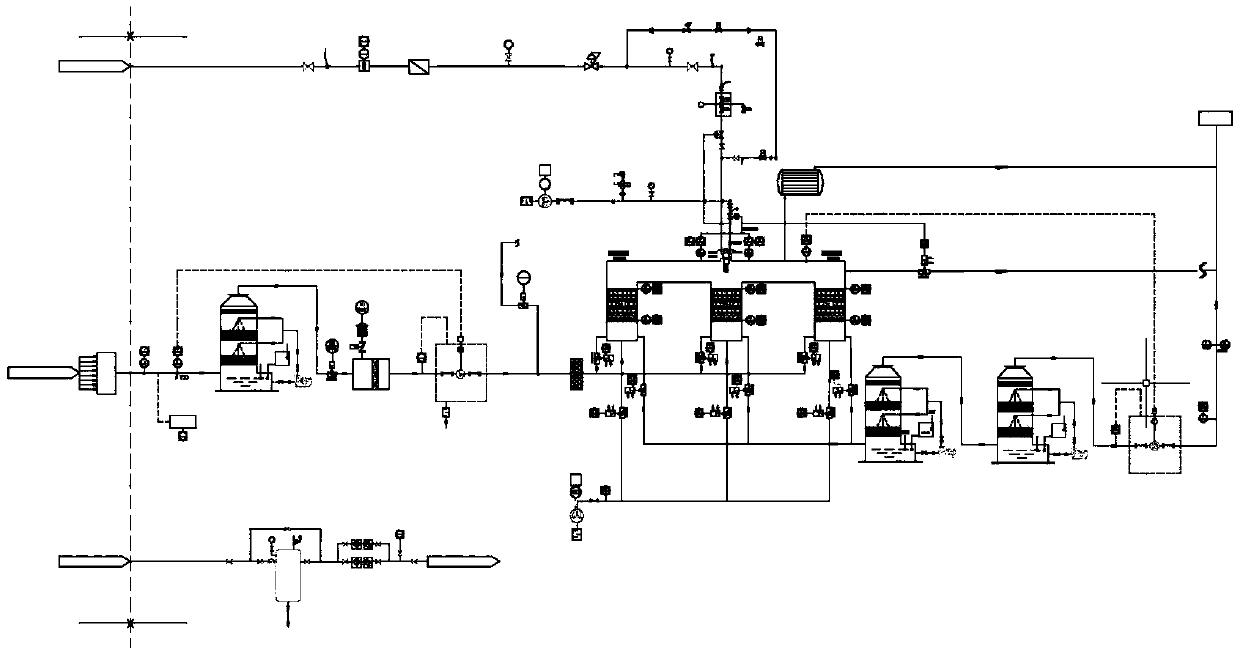Epoxy propane chlorohydrination tail gas and trichloroethylene workshop waste gas combined treatment process
A technology of trichlorethylene and workshop waste gas, applied in the direction of joint combustion mitigation, chemical instruments and methods, incinerators, etc., can solve the problems of secondary pollution, high equipment investment, high fuel consumption cost, etc., and achieve fuel saving and high calorific value , The effect of saving equipment investment
- Summary
- Abstract
- Description
- Claims
- Application Information
AI Technical Summary
Problems solved by technology
Method used
Image
Examples
Embodiment 1
[0036] A process for joint treatment of propylene oxide chloroalcoholization tail gas and trichlorethylene workshop waste gas, comprising the following steps:
[0037] The chloroalcoholization tail gas of the propylene oxide plant and the waste gas of the trichlorethylene plant are safely mixed.
[0038] The combined gas mixture is subjected to regenerative combustion.
[0039] Waste heat recovery and utilization of high-temperature flue gas after combustion.
[0040] The low-temperature flue gas after combustion is neutralized and discharged after reaching the standard.
[0041] The waste gas from the trichlorethylene workshop is treated with primary and secondary alkali washing to avoid corrosion to subsequent pipelines and equipment, and is transported through the waste gas conveying fan. Since the waste gas contains organic combustible gases such as non-methane total hydrocarbons, A small amount of nitrogen is added to the root of the outlet pipe of the fan to dilute the...
Embodiment 2
[0056] For the convenience of understanding, the present invention also provides corresponding device schematic diagrams for the treatment process provided in the above-mentioned embodiment 1, as figure 1 As shown, the combined treatment device for propylene oxide chloroalcoholization tail gas and trichlorethylene workshop exhaust gas provided in this embodiment includes the first stage of air intake, the second stage of alkali washing tower, gas mixer, blower, regenerative combustion device, gas outlet Primary and secondary alkali washing towers, induced draft fans, waste heat boilers.
[0057] The beneficial effects of the present invention are:
[0058] 1. Realized the environmental protection standard discharge of the two sets of devices.
[0059] 2. Taking advantage of the high calorific value of the chloroalcoholization tail gas of propylene oxide, at the same time burning off the waste gas from the trichlorethylene workshop, saving a lot of fuel.
[0060] 3. The exhau...
PUM
 Login to View More
Login to View More Abstract
Description
Claims
Application Information
 Login to View More
Login to View More - R&D
- Intellectual Property
- Life Sciences
- Materials
- Tech Scout
- Unparalleled Data Quality
- Higher Quality Content
- 60% Fewer Hallucinations
Browse by: Latest US Patents, China's latest patents, Technical Efficacy Thesaurus, Application Domain, Technology Topic, Popular Technical Reports.
© 2025 PatSnap. All rights reserved.Legal|Privacy policy|Modern Slavery Act Transparency Statement|Sitemap|About US| Contact US: help@patsnap.com

